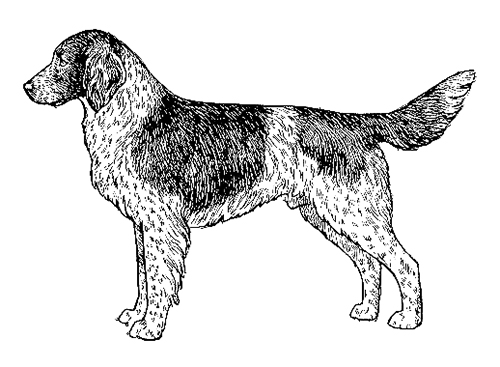Small Munsterlander
Gun Dog Group
The goals and purposes of this breed standard include: to furnish guidelines for breeders who wish to maintain the quality of their breed and to improve it; to advance this breed to a state of similarity throughout the world; and to act as a guide for judges.
Breeders and judges have the responsibility to avoid any conditions or exaggerations that are detrimental to the health, welfare, essence and soundness of this breed, and must take the responsibility to see that these are not perpetuated.
Any departure from the following should be considered a fault, and the seriousness with which the fault should be regarded should be in exact proportion to its degree and its effect upon the health and welfare of the dog and on the dog’s ability to perform its traditional work.
History
The Small Munsterlander originated in Germany. It is descended from the long coated German Spaniels and is a spaniel type dog that points game. In 1921, a standard was drawn up in Germany by Mr. Friedrich Jungklaus, and it has been followed since that time, though the true origins of the breed are not clearly known.
The Small Munsterlander was recognized by the United Kennel Club in 2006.
General Appearance
A medium sized pointing dog of Spaniel type, this breed is elegant and balanced, and has a distinguished air and clean, flowing lines. In proportion it is just slightly longer than tall, and it has a flat glossy coat of good density and medium length.
Characteristics
Equally adaptable as a hunting dog or family companion, the Small Munsterlander is bright, willing to learn and quick to obey.
Head
A proper head is vital to correct type in this breed.
SKULL
Long and lean, flat or slightly arched on top. Stop is slight but distinct.
MUZZLE
Same length as the skull, powerful, with a straight nasal bone and close fitting lips that are fully pigmented, brown in color.
Serious Faults: Muzzle pointed or dished.
TEETH
Large and white, with full dentition, meeting in a true scissors bite.
Disqualifications: Any deviation from a correct scissors bite and/or full dentition, with the exception of missing first premolars.
EYES
Of medium size, with tight fitting lids. Dark brown in color, with no haw showing.
Serious Fault: Light eyes.
Disqualifications: Entropion, ectropian, distichiasis, bird of prey eyes.
NOSE
Brown in color, fully pigmented.
Serious Fault: Butterfly nose.
Disqualification: Nose completely lacking in pigmentation.
EARS
Broad at the base, tapering to the tips, set on high and carried close to head. Pulled forward the leather does not reach past the corner of the mouth.
Neck
Length in proportion to the rest of the dog. Arched at the crest, widening gradually towards the base. Clean and muscular.
Disqualification: Distinct dewlap.
Forequarters
Shoulder blades fit closely to the body, and meet the upper arms at an angle of nearly 90 degrees.
FORELEGS
Straight and set well back under the body, with the elbows close to the ribs. Strong bone.
Pasterns slope slightly. Distance from elbow to ground is equal to the distance from elbow to withers.
Serious Faults: Large, clumsy bone. Crooked legs.
Body
Deep, rather than broad, in chest. Ribs nicely sprung and reaching well back to a short, broad loin. Withers pronounced, leading into a firm, well muscled back. Topline slopes gently. Croup long, broad and well muscled, sloping very gently to the set on of the tail. Elegantly curved tuck-up.
Serious Faults: Shallow chest, narrow or barrel shaped ribs.
Disqualifications: Seriously roached or swayed back. Curved spine.
Hindquarters
Musculature, bone and angulation match that of the forequarter.
HIND LEGS
Upper thigh long and broad, lower thigh long, sinewy and muscular. Good angulation at stifle and hock joints. Rear pasterns short and vertical.
Serious Faults: Cow hocked or spread hocked, either standing or moving.
Feet
Round, with tight, well arched toes. Front and rear feet point straight ahead.
Tail
Set on high, strong at the base and tapering to the tip. Medium in length, with a long flag. When the dog is in motion, the tail is carried level with the back or slightly elevated, and may be gently curved towards the tip.
Disqualifications: Kinked or ringed tail or any other tail deformity such as much too long or too short.
Coat & Skin
Coat is dense, flat lying, straight or slightly wavy. Water, weather and thorn proof. Nicely feathered on ears, front legs, back legs down to hocks and tail, but excessive feathering on chest is undesirable. Skin is tight fitting.
Serious Faults: Smooth, short hair on ears. Curly hair on ears.
Color
Brown and white. Brown roan. Brown mantle. Brown ticked. White blaze and tail tip acceptable. Tan points on cheeks, above eyes and around anus acceptable.
Size
Ideal size for males is 21½ inches at the withers. For females, 20½ inches. Variations of ½ inch either way are not faulty.
Gait
The Small Munsterlander moves with a long, ground covering stride, straight and true, and carries the same profile moving as it has standing.
Eliminating Faults
(An Eliminating Fault is a Fault serious enough that it eliminates the dog from obtaining any awards in a conformation event.)
Fearfulness, or aggressiveness.
More than 1½ inches over or under the preferred size.
Disqualifications
(A dog with a Disqualification must not be considered for placement in a conformation event, and must be reported to UKC.)
Unilateral or bilateral cryptorchid.
Viciousness or extreme shyness.
Albinism.
Any deviation from a correct scissors bite and/or full dentition, with the exception of missing first premolars.
Entropion, ectropian, distichiasis, bird of prey eyes.
Nose completely lacking in pigmentation.
Distinct dewlap.
Seriously roached or swayed back.
Curved spine.
Kinked or ringed tail or any other tail deformity such as much too long or too short.

Looking for a Dog?
Find a dog that will fit your family.
Note: The breeders on this list are not endorsed by UKC.
Revised July 1, 2009
©Copyright 2006, United Kennel Club
